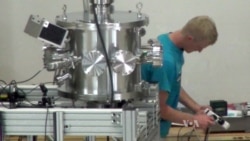"We are stardust" is more than a lyric in a hit 1970's song. It’s actually true. Our solar system began as flecks of star-created gas and dust that drew together to form our sun, the planets ... and us. And there was plenty of dust left over.
So, as NASA's New Horizons spacecraft prepares to begin the first-ever fly-by of Pluto on July 14, dust is one of the data points. And the millions of tiny particles are being counted by a device designed, created and monitored by students at the University of Colorado's Laboratory for Atmospheric and Space Physics.
David James, a research assistant at the lab, recalls that work on the Student Dust Counter began more than a decade ago. He was a graduate student in physics when a friend told him about the project and he signed up.
“She said, 'I’m working on this project that’s really neat. It has a lot of real world applications and you know, it’s eventually going to be launched into space,'” he recalled.
Tiffany Finley was also a graduate student when she joined the team in 2002.
“This opportunity came up and I said, ‘What? You’re going to Pluto? I would love to be part of that,’” she said.
Finley became manager of the project to build a dust counter for the New Horizons mission, a task she said would normally be assigned to professionals.
“As a student project, it’s one of the first where students actually got to build the hardware on the mission," she said.
University of Colorado Physics Professor Mihaly Horanyi has been the faculty advisor for the Student Dust Counter project since the beginning. He notes that, as project manager, Tiffany "was so worried about timely delivery, that she was the first to show up, beating all other professional instruments. The Student Dust Counter was the very first that was bolted on New Horizons.”
Today, Finley is science operations manager for the entire New Horizons mission.
Horanyi says that student labor made building the device affordable, while working on the project has so far helped nearly three dozen students do more than wish upon a star.
Nearing the Goal
In 2006, the briefcase-sized Student Dust Counter launched with the New Horizons spacecraft. During the 25-billion kilometer journey to Pluto, six on-board devices mostly stayed in hibernation. Now they’re awake and beaming back color photographs and analysis of the dwarf planet’s chemistry. However, the Student Dust Counter has been measuring and counting dust hits ever since launch.
Horanyi explains that dust counters help researchers better understand space dust, including the danger it poses to space travelers.
“Hundred-micron-size particles - like the thickness of your hair - if they were to hit the spacecraft at 10, 15 kilometers per second, that’s an 'end of mission' event," he said. "It’s over. It would puncture a hole. It would destroy the mission.”
Tests at the lab accelerate earth-bound dust to the high speeds of dust zipping through space, and the work may lead to more puncture-proof spacecraft and spacesuits, as well as clues for what creates dust far out in space. James, who is in charge of calibrating the machines the scientists use, bragged, “we’ve even reached 107 kilometers per second ... our fastest particle here.”
Speeding particles are more common closer to earth, where they occasionally damage spaceships. In fact, Horanyi says, 30 years ago, fears also ran high about sending a spacecraft through another dusty place — the asteroid belt between Mars and Jupiter.
“It was not clear that you could fly across this region at all, or are you going to be sandblasted and bombarded with sufficient energy and momentum that you would never make it across,” he said.
Fortunately, dust counters on earlier missions into deep space showed low hit rates, even from tiny particles. And Horanyi says that from earth to Pluto, the Student Dust Counter’s been okay.
“Even at Saturn, which has this beautiful ring structure, full with dust, we were never hit by a particle that is a hundred micron or so,” he said.
Now that New Horizons is beyond where any dust counter has gone before, particle hits have been only a handful a week.
“[But] to produce that handful-a-week impact rate on the outskirts of the solar system," Horanyi explained, "you have to produce six tons of dust every second.”
Analysis by the Student Dust Counter team indicates far out in space, a lot of asteroids might be crashing together to make that dust. Horanyi and his latest student team suspect that 5,000 kilograms of dust per second is created by big collisions in the most unexplored - and largest - region of our solar system: the icy Kuiper Belt, which includes Pluto, asteroids the size of mountain ranges and a lot of dust.
After a five-month long flyby of Pluto, most of the instruments on New Horizons will shut down. But as the spacecraft continues through the Kuiper Belt to the edge of our solar system, the Student Dust Counter will keep counting.










